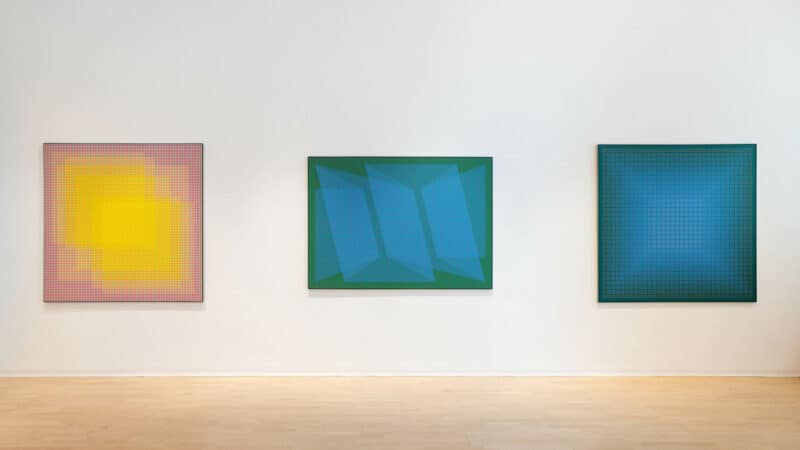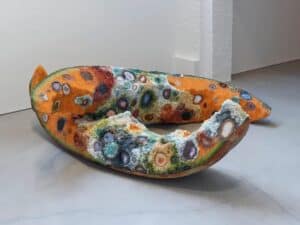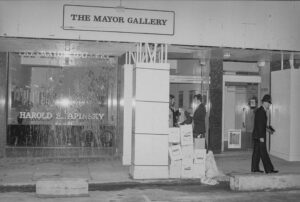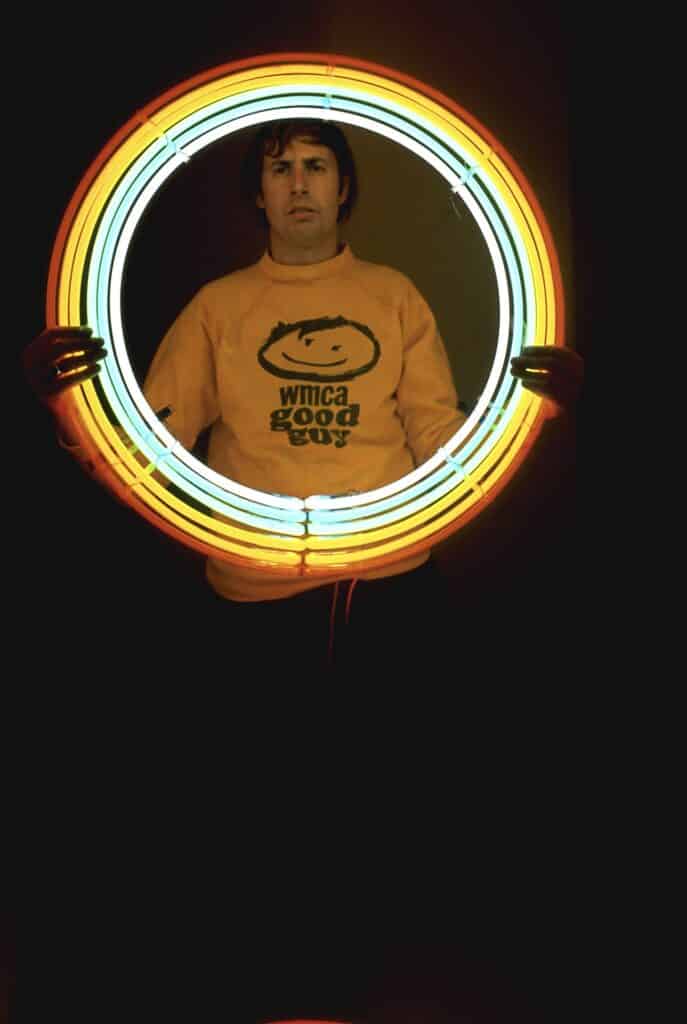
In November 1965, Billy Apple (b.1935– d. 2021 Auckland, New Zealand) staged his second solo exhibition at Bianchini Gallery in New York City. This ground-breaking exhibition is credited with being one of the first to treat electric light as a new sculptural medium, a move that was then beginning to galvanise a range of artists working in the USA and Europe. Taking the rainbow as its central motif, this show proved Apple’s attraction to new products and advancing technologies, and his fascination for the science of colour and light.
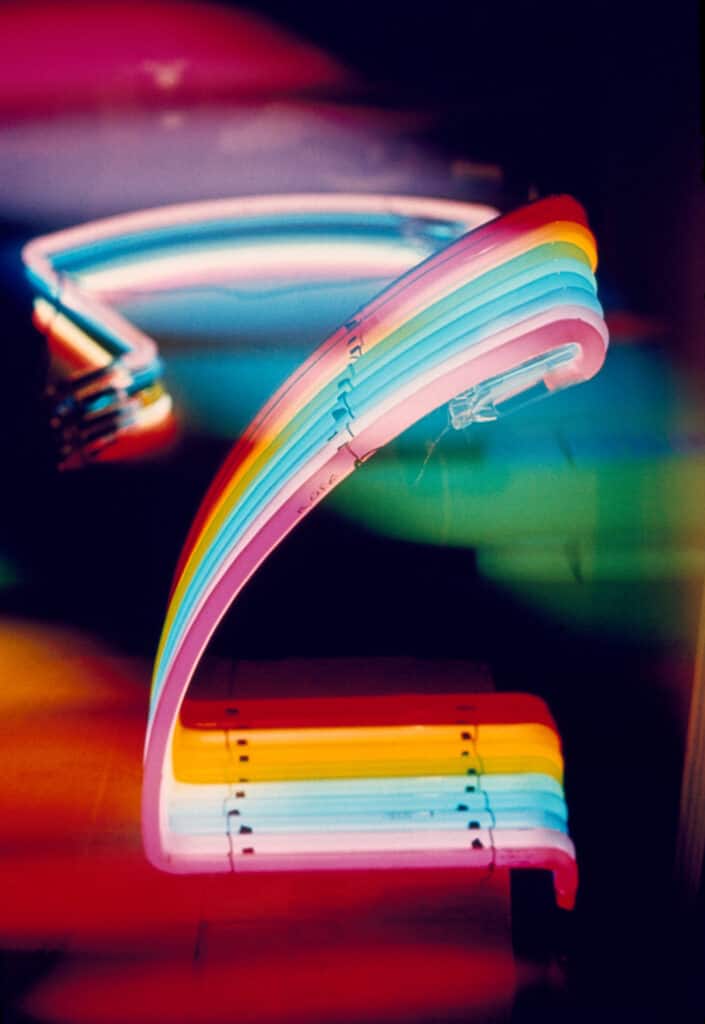
The exhibition featured seven neon sculptures variously based on the rainbow shape and colours. These were placed strategically across the gallery floor to recreate the hues of the visible spectrum with a precision that together made up white light. Along with these floor-based works, Apple included an editioned Rainbow multiple (serigraphs utilising arcs of brilliant fluorescent inks), and five free-standing Plexiglas rainbows, some mounted on acrylic waterfalls, neatly scaled to sit on plinths or shelves that toyed with coloured rainbow light as if it could exist in solid and liquid states.
Now, in 2022, The Mayor Gallery is to restage Billy Apple’s Rainbows exhibition, having worked with the artist’s wife, Mary Apple, to prepare the surviving works still in the artist’s possession. Featuring four original neon sculptures, a rare semi-circular Rainbow print, and three Plexiglas objects, the exhibition will be the first time Apple’s Rainbows have been presented together since 1965.
The show is accompanied by a publication that fully documents the original exhibition and provides a comprehensive annotated catalogue of the works originally displayed.
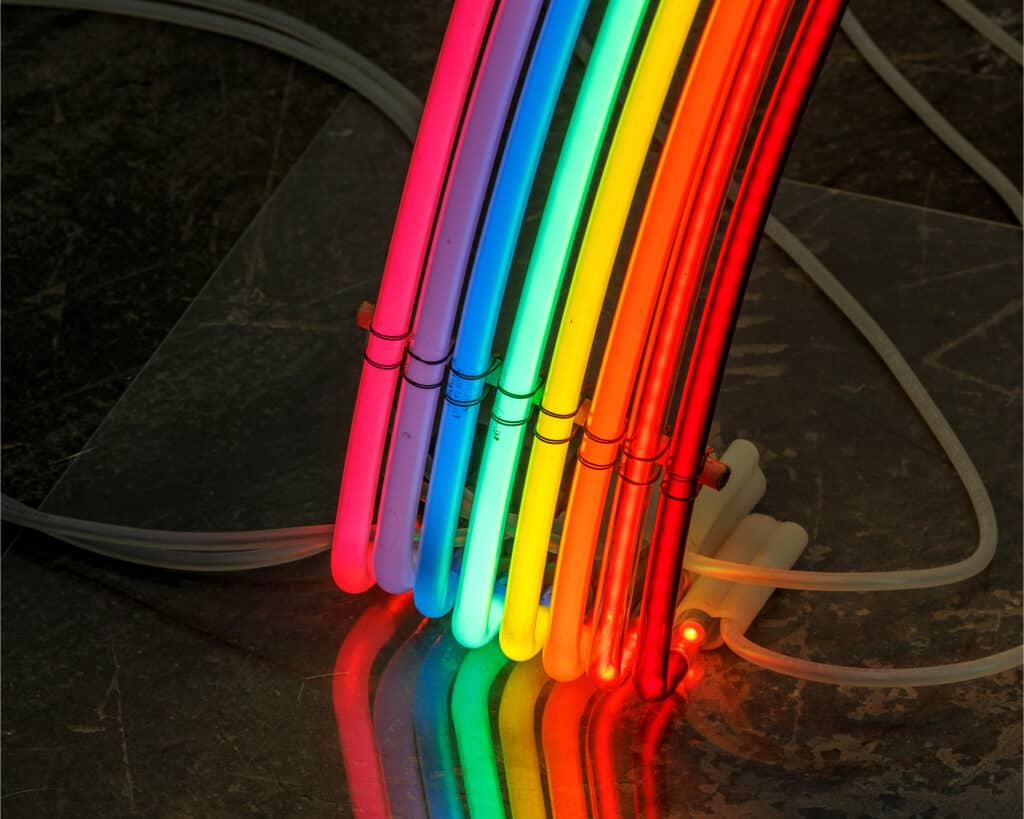
Billy Apple’s Rainbows were described by Robert Pincus-Witten, writing in Artforum in February 1966, as
“among the most beautiful that hover over the present scene”.
They were subsequently included in several exhibitions designed to survey the new medium. These include: Art Turned On (Institute of Contemporary Art, Boston, 1965), Art Electric, Ileana Sonnabend Gallery, Paris, 1966), and Kunst-Licht-Kunst (curated by Frank Popper for Stedelijk van Abbemuseum, Eindhoven, 1966). Apple’s Rainbows presciently point to the adoption of the rainbow as an icon of the 1960s, especially its appropriation as a symbol of peace in the era of anti-war protest. This is long before the rainbow’s role as an emblem for gay liberation and now the LGTBQI+ community. However, Apple’s real attraction was to the science of the natural phenomenon and his keen desire to go beyond conventional paints or pigments and investigate what he termed an “electric palette” that could function, like the refraction and reflection of light through raindrops, as an immaterial emanation of pure colour.
Apple’s curiosity about the potential of neon began early in his career (around 1957), when he was working in advertising in New Zealand and drew on the new medium as a modern mode of signage. He utilised the skills of neon glass benders then and during his student years at the Royal College of Art in London (1959–1962) and immediately after, using the London-based firm, Brilliant Signs Ltd, to make at least three neons for his Pop assemblages.
In New York, where he moved in 1964, Apple lived on the Bowery, at the heart of the lighting district and quickly made connections with the technicians, manufacturers, and retailers who could assist him in his experimentation with the coated glass tubing and mixing of inert gasses for his sculptures. Apple was part of a short-lived wave of interest in electric light as an artistic medium. Between 1965 and 1972, his fascination for neon was a crucial dimension of his transition from making discrete art objects, that contributed to the evolving language of Pop, to working with spaces and materials, as he turned to a process-oriented practice attuned to artistic agendas that prevailed in the early 1970s.
This is Billy Apple’s fourth solo show at The Mayor Gallery and the first to be undertaken posthumously. The Gallery was in discussion with the artist in 2021 when we heard the sad news of his passing on 6 September 2021.
‘Billy Apple ® Rainbows 1965’ The Mayor Gallery 21 Cork Street, First Floor, London W1S 3LZ 18th May – 27th July 2022 Private view Wednesday 18th May 2022, 6–8 pm
About the artist
Billy Apple was born in Auckland New Zealand in 1935. He lived in London between 1959 and 1964 and moved to New York in August that year, where he was based until 1990. From 1990 to his death last year, Apple was based in Auckland, New Zealand, where he conducted a busy career, exhibiting nationally and internationally in solo and group exhibitions. A substantial two-part survey at the Witte de With Center for Contemporary Art in Rotterdam in 2009 reintroduced the artist to European audiences, and, in 2015, Auckland Art Gallery Toi o T?maki staged a substantial retrospective. Apple is represented in major collections in the United Kingdom, the USA and New Zealand. He is widely recognised as a pioneer of Pop and Conceptual art, his works having been included in International Pop (Walker Art Center, Minneapolis, 2015) and Global Conceptualism: Points of Origin 1950s–1980s (Queens Museum, New York, 1999). The Mayor Gallery has recently arranged for sales of his works to Tate Britain, London, Scottish National Gallery of Modern Art, Edinburgh and Philadelphia Museum of Art, Philadelphia.
Billy Apple® Life/Work, a monograph on the artist by art historian and curator Christina Barton, was published by Auckland University Press, Auckland, and Circle Books, New York, in 2020.

